When AI Search Starts Making Money
![]() 11/05 2024
11/05 2024
![]() 414
414
Written by: Hao Xin
Edited by: Wu Xianzhi
Recently, under the influence of the new paradigm created by GPT-4o, AI search and reasoning functions have been launched by Yue'an, Zhipu, Perplexity, and OpenAI.
Unlike the previous "needle in a haystack" approach, AI search has grown a "brain" in recent updates. When facing problems, it can break down steps like humans, conduct precise searches, and finally present answers.
According to the "Knowledge Management Model," data itself is unordered and lacks meaning. It only acquires value as it evolves upwards into information, knowledge, and wisdom. Information solves the "What" problem, knowledge solves the "How" problem, and wisdom at the top of the pyramid addresses the "Why" problem. From this evolutionary logic, AI search empowered by CoT (Chain of Thought) has ushered in the 2.0 era, evolving from information aggregation to rule summarization and decision support.
Users' reliance on AI search has exceeded expectations. Perplexity claims it can handle 100 million queries per week and approximately 400 million per month. It's not enough to just snatch users from giants; more importantly, AI search is sending positive signals in commercialization. The latest foreign report shows that with the development of AI search, Google's search advertising market share has dropped below 50% for the first time in a decade.
Both new and established players are eyeing the "cake" left by Google. Currently, there are two paths: one is to follow Google's lead and create a general-purpose AI search tool, selling usage rights to consumers and advertising spots and AI search capabilities to businesses; the other is to embed AI search capabilities into scenarios through applications, aiming to bypass search engine intermediaries and build self-distribution channels and data entry points. This not only optimizes the user experience through search, increasing the likelihood of paid services, but also prevents intermediaries from profiting, enhancing profitability.
Yue'an is aggressively engaging in hunger marketing, frantically scoring points, and showcasing its presence as the "first domestic 4o search" in China; Minimax, which has earned repeat business through Talkie, is focusing on AI application search and recommendation; even the usually slow-paced WeChat is seeking change, conducting a gray test of its AI Q&A function to connect the Hunyuan and WeChat ecosystems.
'The more consensus, the higher the threshold.' Some industry insiders believe that widespread optimism about AI search has intensified competition. 'If you're not outstanding, people will still choose Google.'
Search + Deep Reasoning = ?
The demand for Disassemble and analytical abilities in AI search under deep reasoning mode far exceeds the act of "searching" itself. The underlying logic of search and recommendation is nested in the process of finding and solving problem answers.
Combining the user experiences of Perplexity and Kimi, the basic process of AI search and reasoning mode is as follows: Pose a question that may involve extensive searches and multiple intents. Instead of rushing to answer, the AI first solves the problem by breaking down a complex instruction into several steps, then sequentially completes "search + analysis" actions, and finally presents the answer.
Previous AI search was like a "bookworm," looking for answers in a question bank with keywords. Current AI is a "clever guy" that answers point by point according to the solution steps after grasping the problem-solving ideas. Moreover, the entire problem-solving process is real-time and dynamic, with thinking and answering occurring simultaneously.
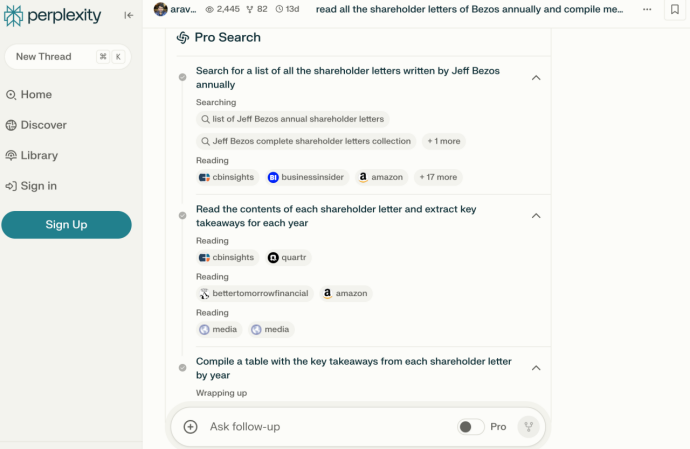
(Source: Perplexity)
Taking the case provided by Perplexity as an example, the question is, "Read all of Bezos' annual shareholder letters and list the key points for each year in a table." To solve the problem, the AI breaks it down into three steps: "Search and find all annual shareholder letters from Bezos," "Obtain the content of each shareholder letter from Bezos," and "Create a table of key points from Bezos' annual shareholder letters." If using the Kimi Explorer version, it will search again after generating the answer to complete a "post-reflection supplement."
'Search + Deep Reasoning' can be viewed as an Agent executing search tasks, so you can see that the AI provides feasible operation steps rather than search keywords like "Bezos," "shareholder letters," or "key points." The underlying logic of AI search has changed, shifting from "finding" to "solving," with the act of "searching" becoming a subset of problem-solving. If search is viewed as a tool to assist in problem-solving, this subset can be infinitely expanded, such as documents, knowledge bases, PPTs, office software, etc. The openness and scalability of Agent tools set the stage for improving search quality.
Of course, for now, the Search Agent has its own irresolvable flaws.
During testing by Guangzi Planet, it was found that when over-emphasizing the completeness of search steps, the process can be correct but the result wrong. This means that while individual CoT chains are fine, errors occur in the connections between chains. In some problems, there is a "ghost wall" phenomenon, with search and step breakdown actions repeatedly cycling, which is a huge waste of computing power.
As mentioned above, a good problem-solving approach is more important than searching. When CoT replaces RAG as the standard, it's crucial to be vigilant against the tendency to complicate simple problems. For example, in some classic logic problems, where a two-step solution would suffice, forcibly adding an analysis process instead increases the difficulty of searching. The quality of CoT construction matters, not just the quantity.
AI Search Advances to 2.0
Beyond the context of a single function, AI search has taken another step towards solving problems.
The content filtered by search has dimensions. The bottom layer is information. In the Internet era, search matches keywords to an information pool, and users must manually click to screen pages. AI search first filled this gap, allowing connected AIs to obtain definitive rather than vague answers after searching on their own.
However, at this stage, users' perceptions are very clear. Assistants like ChatGPT can only answer 4W questions: "Who, What, When, Where." The advantage of aggregation is that users don't need to open multiple webpages to understand the basics of something. The key to limiting the usability of AI search is search volume – the larger the search range, the more comprehensive the 4W coverage, and the accuracy can be improved through quantity.
Knowledge is further refined from information, involving deep understanding and processing of information, discovering patterns and trends through extensive searching and comparison. Wisdom is a further elevation of knowledge, guiding decision-making and execution through the application of patterns.
AI search in the 2.0 stage is between knowledge and wisdom. For example, you can ask follow-up questions like, "What are the keywords Bezos frequently mentions?" or "How have the key points mentioned by Bezos impacted Amazon's development?" You can also upload the "Art of War" document and ask the AI for development suggestions for Amazon. These queries go beyond the 4W level, delving into How and Why questions. It is precisely because the dimension of search and information processing has increased that its value has risen accordingly.
For now, there is not a significant gap between the two search methods of open-book exams and independent thinking. The same question can yield answers of similar quality using keyword searches. From information to wisdom, AI 2.0 search is betting on long-term value, but given the current insufficient investment in post-training reasoning, this will still take time.
Besides the CoT approach, AI search has other enhancement methods. Information search is the foundation, from which three ideas emerge: one is to expand search volume and scope. The search volume of the Kimi Explorer version is ten times that of the standard version, allowing for in-depth reading of over 500 pages per search.
The product lead of the Kimi Explorer version once concluded, "If Kimi can't find the information, it's highly unlikely that users can find it themselves through traditional search engines." His underlying message exudes confidence in Kimi's search volume but overlooks the fact that "comprehensiveness" does not equal "accuracy" or "quality."
This gives rise to the second idea: premium search. The core is to filter out redundant and low-quality information in advance, ensuring search pool quality before developing search capabilities. It's like establishing a search funnel, with unfiltered information at the top, filtering according to AI search company or user customization standards in the second layer, and further segmentation in the third layer, such as relevance strength, similarity, priority, etc., redistributing information gatekeeping and distribution rights.
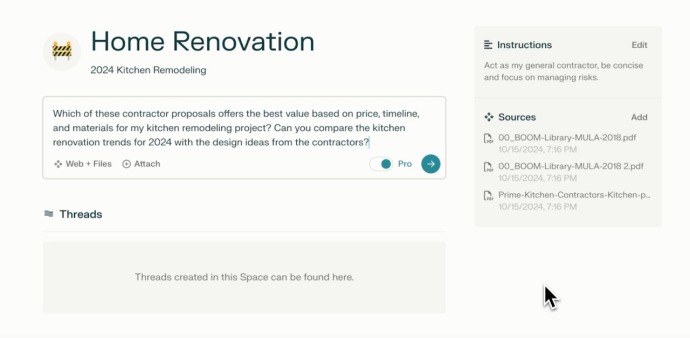
(Source: Perplexity)
The last approach is to directly supplement information sources because no matter how you choose between quantity and quality, it may not meet user expectations. If so, it's better to allow users to upload their own data and text. Perplexity currently supports users in building their AI research and collaboration centers, where users can upload internal knowledge bases and combine web searches to obtain targeted answers.
"Dividing Up 'Google' – Everyone Gets a Share
Traditional search is declining, while AI search is advancing, with this trend becoming increasingly prominent. Currently, AI search is a must-compete area.
Job postings show that among the AI Six Tigers, Yue'an is heavily investing in AI search and reasoning, with numerous positions involving reasoning and engineering optimization. Functionally, it is increasingly similar to Perplexity. Meanwhile, Minimax is also recruiting search recommendation-related engineers but with a different focus, centering on algorithms and advertising placement optimization within its AI applications.
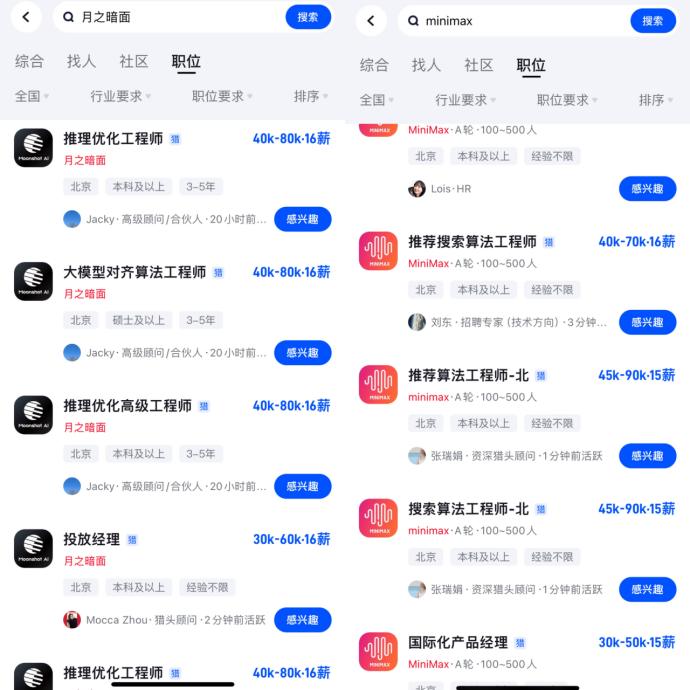
(Source: Job search platform)
No one knows how long the window of opportunity will remain open for new players. It is urgent to quickly seize the emerging "cake." The previously accumulated user base and retention have become "bait" for AI search, now ripe for advertising monetization. It is reported that Perplexity will soon launch advertisements within its app, with potential ad spots including media sponsorships for "answering questions," "related questions" below search answers, and video placements in "prominent positions."
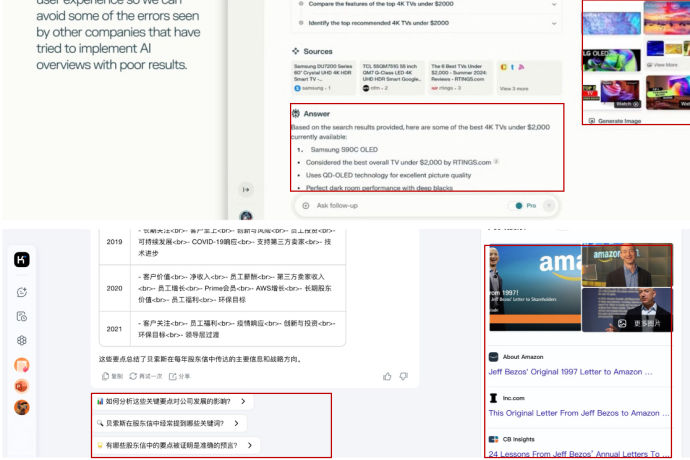
(Source: Perplexity, Kimi)
Taking a cue from Perplexity, the Kimi Explorer version has revamped its free version interface, adding a search display page and reserving advertising spaces. Kimi itself is free to use, and its company, Yue'an, has no other businesses. Investments in traffic, computing power, and human resources urgently need funding, with To B advertising revenue being one option.
The premise of "secondary sales" is selling "users," and user demographics determine who to sell to. Data shows that 65% of Perplexity's users are "high-income professional white-collar workers" (medicine, law, software engineering), with 30% in "senior leadership positions." This positions Perplexity to target the high-end advertising market, including technology, finance, and art. Media reports indicate that Perplexity's CPM (cost per thousand impressions) advertising fee is over $50, 4.5-20 times the market average.
This is not favorable for Kimi and its peers, whose typical user profiles include college students, entry-level white-collar workers, stay-at-home moms, teachers, etc. For advertisers, these users have relatively limited spending and conversion capabilities. Perplexity's user pricing is on par with ChatGPT, having completed user screening in just over a year. Domestic AI search and assistant apps have adopted a free strategy to compete for the market. While this has increased visibility, it has made charging more difficult, with a broader user base implying a fuzzier advertising market.
Notably, Perplexity has drawn inspiration from Notion's collaboration spaces to provide an AI search-to-small B model. By opening up its AI search capabilities, Perplexity enables knowledge sharing and improves the efficiency of retrieving and analyzing problems, partially replacing "RAG + knowledge base" solutions. There is significant room for imagination in this version, such as providing channels for integrating AI search into software ecosystems. Like Notion, it opens itself up to allow other products' APIs to access, both compensating for capability deficiencies and increasing user utilization.
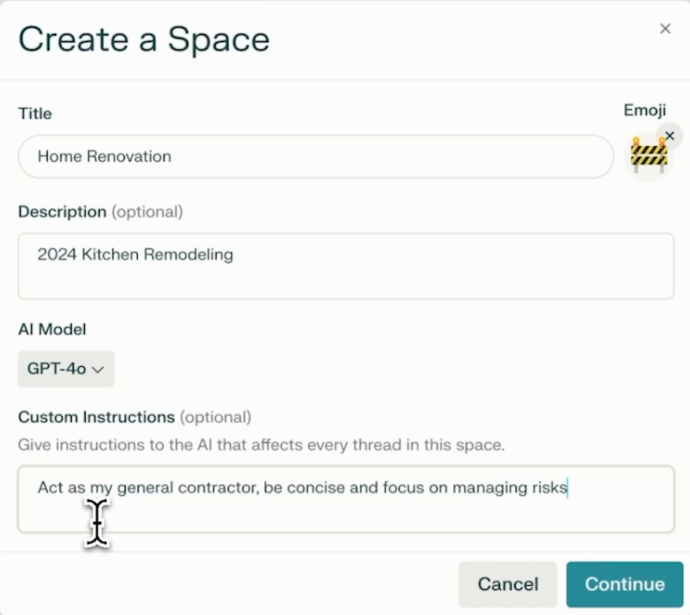
(Source: Perplexity)
Building on this, the subscription-based pricing model is further stratified. Besides the original professional version pricing model, there will also be pricing based on enterprise size: small, medium, large, and customized solutions.
Various signs indicate that the AI industry is entering a revenue and profit-oriented stage. Search is hailed as the "field closest to money." If AI search can make a splash as the first stop in large model commercialization, it will undoubtedly be a shot in the arm. As Google steps back, who will take the first bite of the "cake"?








